Global education systems are embracing a technological transformation to meet the current demand for high-quality, personalized, and affordable educational services. The latest digital technologies penetrate into all educational processes: teaching, learning, assessment, and performance reporting. Not surprisingly, the e-learning market is forecast to reach $400 billion by 2026. Global shifts in user preferences, backed up by EdTech market forecasts, show that the expected growth in educational apps has already begun.
As a startup, you may take this chance to bring your EdTech idea to life, making a notable impact on education by developing a great solution to unresolved educational challenges. By doing it well-prepared, the chances to succeed are higher. Based on our expertise in EdTech app development, we invite you to read our informative guide to help you learn how to build a high-quality, user-friendly, and compliant EdTech solution. So, let’s together outline the steps to get started right.
EdTech Application Development market overview
EdTech software (i.e., education technology) are applications that support, facilitate and enhance education by incorporating technology into the learning process. Nowadays, the widespread use of technology has replaced traditional teaching methods and approaches. With a significant rise in the adoption of different technologies, education has become easy to use and access when it’s convenient for users.
By approaching interactive solutions, students and teachers, educational institutions, or any specialists willing to get an education – can get efficient and personalized education experiences based on individual needs.
The current EdTech landscape is rapidly moving forward while becoming a promising idea for investment. The US, UK, and Germany are the main growth drivers of the EdTech industry. According to Grand View Research, the global EdTech market is forecast to expand at an annual growth rate (CAGR) of 16.5% from 2022 to 2030. About 47% of the global EdTech market growth will occur in North America.
Another growing trend that increases these statistics is the use of ebooks. Students gain more flexibility and simplicity by accessing and analyzing electronic materials faster and more conveniently.
As you can see, EdTech software development is a promising idea worth investing in. However, to compete with market giants, you need to create a solution that is unique, engaging, and makes life easier for learners.
EdTech Application Development solutions to invest in
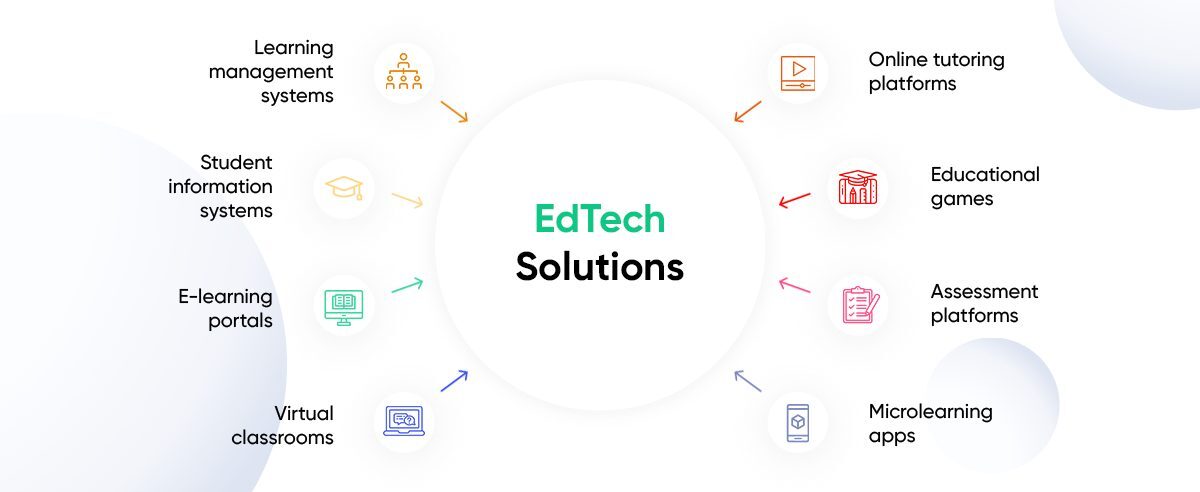

EdTech software solutions
To address unmet demands and offer rescue solutions for a wide target, there are many ways you can do it. Let’s consider cutting-edge solutions your business can offer your audience to help reach new educational heights.
Learning management systems
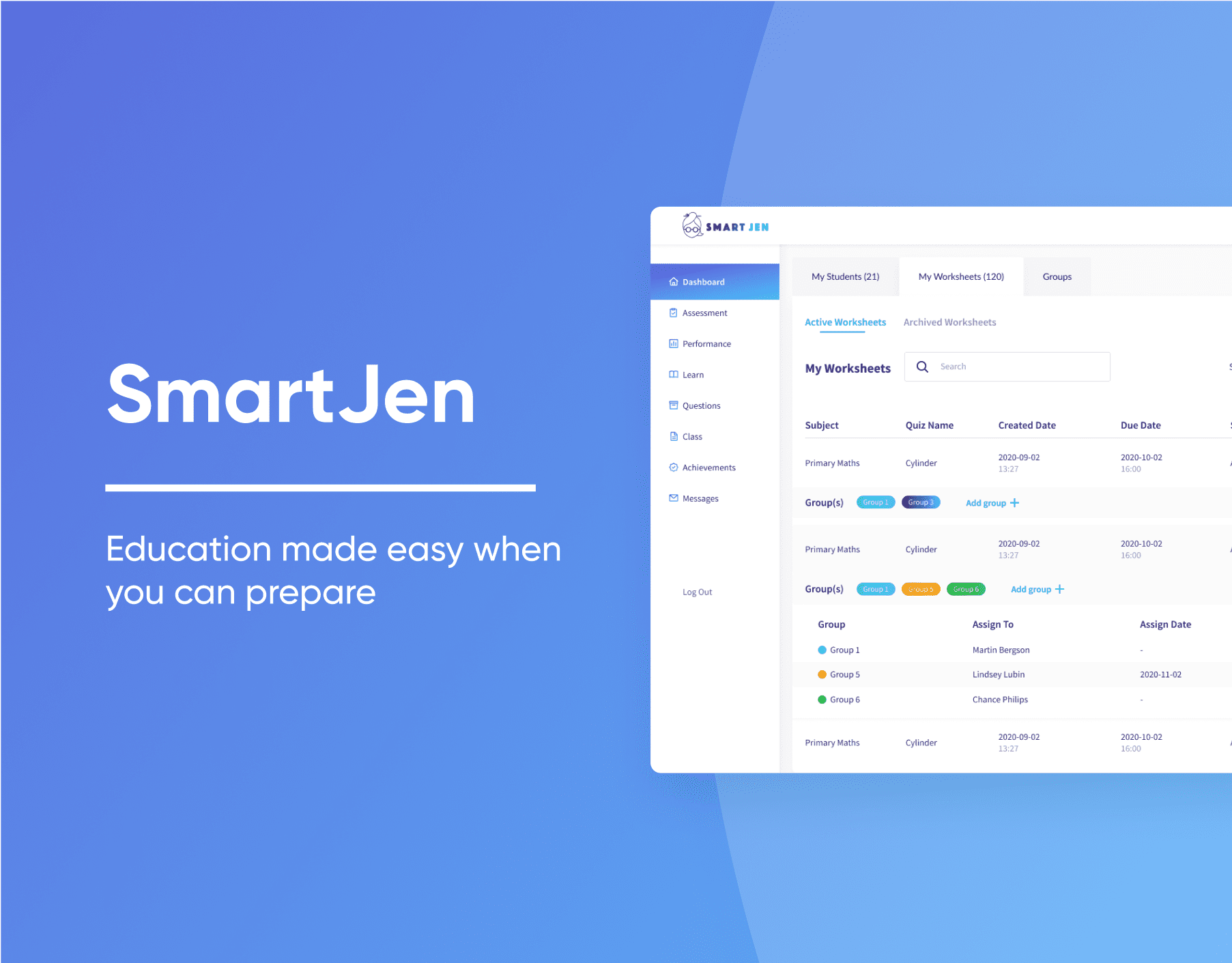

SmartJen
A learning management system (LMS) is software that supports online education by allowing you to create, plan, manage and assess the specific learning process. LMSs can be used in both education and business settings to run training, learning, and development programs. The typical examples often provide built-in virtual classroom capabilities, polls, quizzes, and communication interfaces (messaging, video conferencing, and file sharing).
Student information systems
Regarding educational institutions’ environment, student information systems can include scheduling, academic tracking, course registration, grade results, etc. Such software allows for keeping student records in one place, managing the education process, handling billing, and keeping track of progress and performance.
E-learning portals
The E-learning portal is a web-based application that offers online access to a variety of courses, presentations, podcasts, and content management for intensive learner interaction and collaboration. Such a business idea is valuable in helping teachers and students access relevant learning content and communicate effectively in all contexts across all devices.
Virtual classrooms
A virtual classroom is an online teaching and learning environment where members of a virtual classroom can interact with each other through unique course material, interact with others, or work together in groups. This online video-conferencing tool implies live interaction where users can record the sessions, engage the participants with different quizzes and pools, display learning materials via interactive media files, and share screens. All these features make online learning more efficient and attractive to all participants.
Online tutoring platforms
Online tutoring platforms are online educational platforms that allow users to build the learning process from finding a highly qualified tutor to delivering lessons. Such solutions can provide learning management solutions, academic development content, and e-learning tools. This way, tutors can create and manage the education process and teach innovatively.
Educational games
Interactive learning is a widespread EdTech trend that entails adding gamification features to learning. This allows attracting learners to play a game while gaining knowledge. Educational games can be adapted and designed specifically for teaching kids, college students, adults, high-school students, etc.
Assessment platforms
Through the assessment platforms, teachers can create tests, assess students’ skills and knowledge, and check their understanding of information. Based on student achievement, teachers can set and manage scores or offer different rewards through the online environment.
Microlearning apps
This specific EdTech application allows you to break down the educational process into parts, making learning more convenient and easy for learners. For example, you can create an enterprise learning solution and provide employees with concise educational content that can fit into their daily workflow and be accessible on any device.
As you can see, digital technologies and an abundance of high-performing solutions can help you meet your goals and realize any app concept without effort. Below, we invite you to explore the EdTech solution the RewiSoft team has been working on recently.
RewiSoft Expertise in EdTech Application Development: Miestro


Miestro
Miestro is an all-in-one system that makes it easy to create beautiful online classes, member sites, and workshops and sell them to customers. Using this streamlined educational tool, experts can easily create, track, manage and reward their students by providing an engaging online learning experience.
Main challenges:
- Update existing functionality with new features to improve the process of creating an online educational process and selling it trough a single digital tool
- Update and improve the platform UI/UX design concept to make the platform attractive, easy to navigate and use, while providing a convenient and engaging experience for both students and experts
Solutions:
- Our team has reorganized the website structure in a way to make user interaction more intuitive and clear
- We have reduced old functionality, removed unnecessary features, and added new ones to simplify the process of creating educational content
- The interfaces of the platform have been greatly improved by reorganizing the structure of the main sections and integrating top-level technologies, making the platform fast and reliable
The RewiSoft team has achieved the main goals of our clients and provided professional assistance to make the platform better and more accessible to users.
As a result, this system allows building the learning process through an advanced ecosystem that offers all features to help broadcast the expertise, create an exciting masterclass, share valuable knowledge with learners, and get paid most suitably.
We can bring it into reality!
Get started with EdTech app development
Whether you’re running into difficulties or concerns, need to get started developing an EdTech application quickly, or looking for a ready-to-use strategy to make your EdTech idea viable, the following guidelines will come in handy.
Start with MVP to build a profitable EdTech app
Your initial business hypothesis triggers your project development team to start gathering information to see if it makes any sense to invest further in the idea. To achieve real business value, your solution should provide increased engagement, high availability, and personalized experiences and acquire a high demand from your target audience.
On the one hand, you can focus on market research, closely exploring customer needs, evaluating competitors, and choosing top-notch functionality for your solution right from the start. On the other hand, there is a proven way to measure your business success while taking each step clearly and precisely.
Start with creating MVP and focus on the education app’s core functionalities. Such an approach allows startups to rapidly find the best working business model matching the primary goals, budget, and expectations. In such a way, you can learn your target audience wisely and create outstanding EdTech products. If your idea is potentially noteworthy, you can move on to scaling your MVP by adding additional features that will increase user engagement and deliver high-quality, affordable learning experiences.
To fill in the gaps in this topic, learn what the overall MVP development process looks like, and then continue to turn your MVP idea into reality.
Update the existing educational system
Among other EdTech software development services, the RewiSoft team provides expert guidance and help in updating existing educational systems. If you already have a system that works in an online learning environment, you can get professional advice and redesign your application to meet the latest EdTech standards, enhance security, and improve usability or add new functionalities to stand out above competitors.
Increase the performance of your EdTech solution
If your solution lack digitalization, automation of manual processes, and optimization, you can easily find a proven way to generate more revenue and offer unique educational experiences to your customers. By increasing the performance of your EdTech solution and automation of routine processes, your business will remain competitive and profitable. More personalized practice, ease of use, and high-quality features that help make eLearning more effective will keep your solution one step ahead.
A step-by-step process of EdTech application development
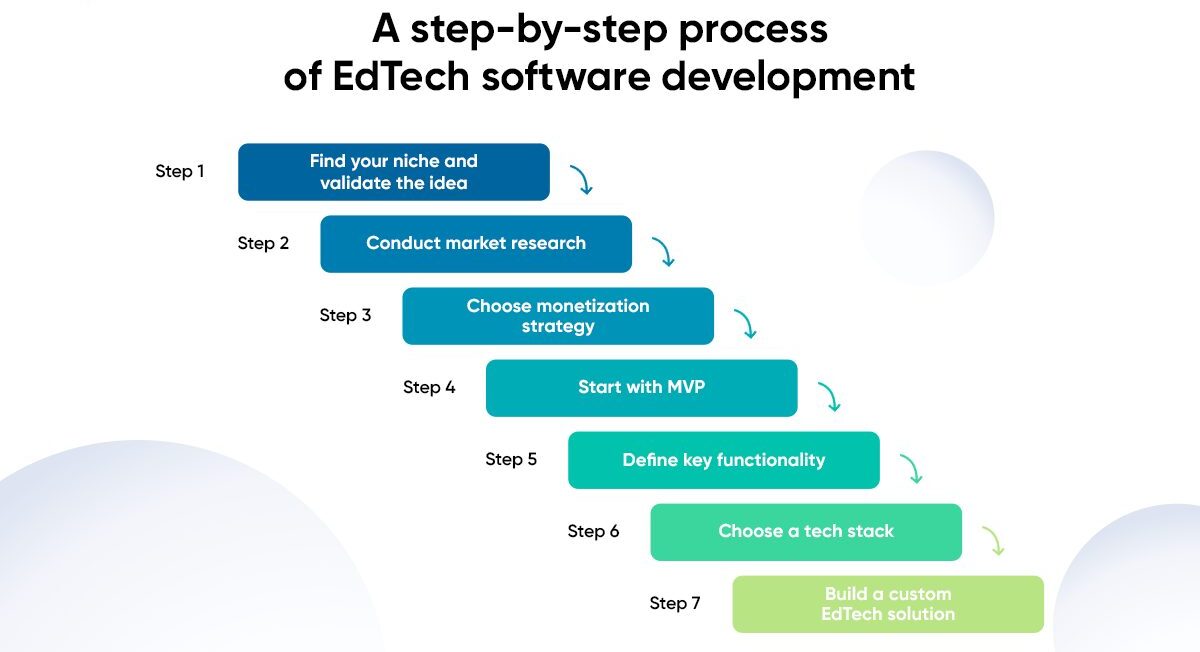

A step-by-step process of EdTech software development
A successful business plan starts with thoroughly planning essential project milestones and iterations. From concept definition to the EdTech software development, let’s discuss what steps you need to take in the process.
Step 1. Find your niche and validate the idea
Being scattered among different target audiences will not play a good joke in your overall business strategy. By narrowing down the niche, you’ll be able to address the best EdTech solutions to solve the pain points of your target audience. For this reason, start with choosing to focus on a single niche, e.g., mobile learning, corporate training, online training constriction platform, etc. Then research your niche, analyze their primary pain points and needs, and consider the solution and benefits your app will provide for the target market.
Step 2. Conduct market research
One of the vital steps to verifying the feasibility and market viability of an EdTech project is in-depth market research. Let’s break down the market research tasks your team should complete to come up with a sound development plan.
- Analyze direct competitors to get to know what products your competitors offer
- Analyze chosen target audience by analyzing the activities and habits of your potential users to create a more precise user profile
- Document the list of project expected deliverables, software functions, deadlines, tasks, and costs
- Map out project milestones and scope of tasks to provide an efficient EdTech app development workflow
Step 3. Choose monetization strategy
You can choose different revenue sources by providing EdTech solutions to your target customers. So, you should think through the monetization strategy to succeed in the long run. The most common types are:
- Freemium – this model offers users free limited functionality with an offer to unlock full functionality in the premium version for a fee
- Subscription-based – implies charging your users (schools, universities, teachers, students) for access to the services or product features
- In-app purchases – using this model, you will make money from selling additional features, courses, or services
- Ads – this revenue-generating model implies making money from video advertisements or banners
Step 4. Start with MVP
As we already mentioned, a minimum viable product (MVP) is the way businesses validate their business idea and test demand for a product with minimal investment. In such a highly-competitive market, it’s better to start small. With only basic functionality and a limited budget, you can see if your personal finance app idea is viable.
Building an MVP is the most optimal to:
- Gather your target audience feedback
- Test your product on real users
- Prioritize core MVP functionalities
- Prioritize the list of features for the next development stages
- Increase brand awareness
- Get your first return on investment (ROI) if your idea is worthy
Step 5. Define key functionality
Depending on the EdTech app concept, the key functionalities of your final solution will vary. However, some are suitable regardless of the EdTech project needs.
- Communication features – implement video conferencing, text messaging, forum boards, etc., to support efficient collaboration between groups, teachers, and students
- Search and filters – to enable easy searches for necessary materials, courses, or other educational content
- Authorization – easy-to-access login via email or phone number to start using the solution
- Profiles – personal profiles with personal data and customized settings for users
- Payment functionality – payment functionality must be secure, so you should integrate a secure payment gateway to protect customer payment data
- Assignment and assessment features – to facilitate efficient collaboration, you can include task assignment features, progress tracking, file-sharing features, data storage options, etc
Step 6. Choose a tech stack
Once you have an idea of the required features and a ready-to-follow project development plan, you can start choosing the tools and technologies to create your EdTech solution.
At RewiSoft, we prioritize the following technologies and tools:
| Task | Technologies required |
| Product requirements | Discovery workshops with G-Suite representatives |
| Design and prototypes | Figma, Adobe XD, InVision, Sketch |
| Frontend development | Markup and programming languages – HTML, CSS, or JavaScript Frameworks – React.js, Vue.js |
| Backend development | Programming languages – Ruby, C++, PHP Frameworks – Node.js, PHP (Laravel) |
| Database | MongoDB |
Important to note that the tech stack will vary depending on the team you’ll collaborate with. However, don’t hesitate to ask your questions and voice your concerns on this matter before going into design and development.
Step 7. Build a custom EdTech solution
After all critical project milestones are planned, the team starts working on designing the first EdTech app prototypes and wireframes. Prototypes and wireframes are preliminary models of the look and feel of your final product, which may include content, visual design, and interactivity. It is also a good practice to perform user testing to test EdTech’s layout to get first feedback and ensure the app’s interfaces and user experience are simple and clear.
We then go to the development, where our team starts implementing each app’s feature according to specifications. We adhere to the agile methodology to make the EdTech software development process flexible and transparent for our customers.
Want to learn more about what the process looks like in detail? Find out more about RewiSoft’s software development.
EdTech application development standards and compliance requirements
To ensure your EdTech solution meets the latest industry standards and requirements, let’s go through a list of technical standards and regulations to consider.
DOE
When starting to develop EdTech applications, make sure your software meets the Department of Education (DOE) standard if you plan to introduce it to the US. The DOE proclaims a national education technology policy that sets out a vision for how technology can be used for teaching and learning.
GDPR
Another standard that implies high data protection and security protocols implementation is the General Data Protection Regulation (GDPR) to introduce the product in the European Union. The main purpose of the GDPR rules is to protect the customers’ personal data from being collected and used. In a nutshell, GDPR requires:
- Restricted access to personal data
- Limited personal data processing
- Transaprent user information
- User rights to personal data
- High security of personal data, which implies the use of the best digital security practices
SCORM
The Shareable Content Object Reference Model (SCORM) is a set of standards that facilitate the interoperability of e-learning technologies. This education software development regulation ensures compatibility and smooth data exchange between different types of educational software. Depending on what you need from the content and what type of data is necessary to support in the system, there are different versions of SCORM: SCORM 1.1, SCORM 1.2, SCORM 2004 2nd Edition, SCORM 2004 3rd Edition, and SCORM 2004 4th Edition.
LTI Certification
Another important standard in EdTech industry is Learning Tools Interoperability (LTI) Certification. To qualify for certification, education technology software must pass several connectivity tests. If your solution communicates smoothly and efficiently with other certified types of educational software, it is LTI compliant.
xAPI
Experience API (xAPI) is the type of API specification that allows developers to collect data on user experience with their products. The implementation of xAPI contributes to the successful marketing of your solution since the collected learning statistics can be analyzed and used for future business growth.
WCAG
Web Content Accessibility Guidelines (WCAG) provide valuable recommendations to make web content more accessible. These policies will help make the EdTech app easier to navigate and use to meet the needs of people with disabilities and make it accessible to all organizations and governments internationally.
EdTech app development best practices to follow
Below you can see the practices we follow when building EdTech software. Following below-mentioned tools and methods allow us to build reliable, scalable and user-friendly EdTech solutions.
Focus on research
Start deep research into user personas and learning principles to develop an engaging and motivating EdTech app for learning and teaching.
The detailed elaboration on user profile and market competition analysis will help your business to gauge a demand for the educational software or service provided. A strong focus on research will aslo help your business choose a viable business model and carefully plan all phases of a project, from the initial concept definition to the selection of software specialists and tools.
Useful tips from RewiSoft for market research:
- Wisely explore competitor’s products and services
- Find as many relevant online resources as you can to find important information
- Conduct questionnaires among potential users
- Consult with education stakeholders to learn more about pain points or challenges facing the education industry
Ensure strong security
Another area of major concern is the implementation of strong security and privacy practices in the software since the EdTech app store personal data. To prove compliance with industry regulations and ensure strong security, you must adhere to the rules we mentioned earlier, as well as general security practices that deal with customer data.
For example,
- Incorporate two-factor authentication (2FA) to verify logins and authorize users
- Provide data storage, local database, API communication and cache encryption
- Strengthen network security
- Integrate safe communication standards
Improtant to note, the EdTech builders in the US must also adhere to several federal laws:
- Family Educational Rights and Privacy Act (FERPA)
- Protection of Pupil Rights Amendment (PPRA)
- Children’s Online Privacy Protection Act (COPPA)
Provide easy-to-navigate and clear design
The design of your Edtech solution is another vital aspect of keeping users engaged and motivated. Users have to focus on learning content and use your solution without any extra effort.
At RewiSoft, we strive for adopting UI/UX best design practices and design trends to create simple interfaces and smooth user experience. To intensify our efforts to create exceptional designs, we also conduct user testing with the eye tracking tool in our own UX Lab to uncover user behavior patterns to improve usability and increase conversions.
The rest of design practices we follow for EdTech app development are:
- Include more visual content such as interactive infographics, short videos, mini quizzes
- Prioritize short text blocks to ensure the educational content is concise
- Make intuitive design by following the 2-tap rule
- Make responsive design versions across all devices and operating systems
- Follow Google or Apple’s acceptance policies if we’re developing mobile app versions
- Provide a clear visual hierarchy
- Use easy-to-read typefaces
- Ensure high accessibility
Integrate other systems
Seamless integration with learning management systems makes it easy to communicate with the software already in use. Especially if we develop EdTech software for schools, a wide range of educational programs work with Google Classroom LMS, Studyo, etc. Thus, integration with other systems and software is essential for the successful incorporation of a new solution into the existing educational infrastructure.
Pitfalls of EdTech app development: mitigation techniques from RewiSoft
As with any complex development process, there are potential risks that you may encounter. The RewiSoft team has carefully analyzed the common problems our customers face to help you solve them right from the start.
Not viable idea
Problem: As we mentioned earlier, the focus on research and market analysis is important for your app to survive in the rapidly growing EdTech software market. If you hinder this process and do not allocate enough time, there is a risk of financial loss.
Solution: Hire a team to verify your Edtech app idea viability and create a foundation for the development and product vision. Ensure you have experienced business analysts and product managers to help analyze competitors, and estimate the scope of work, resources, and efforts required to set up an efficient Edtech app development process.
Wrong target focus
Problem: Another major problem that can arise from poor market research is choosing the wrong target focus. Focusing on a single EdTech area will narrow your focus allowing you to closely explore the primary needs and pain points of potential customers.
Solution: The right EdTech app development team is well versed in qualitative market research. The data generated from the research is the basis for building mission-critical features that address your audience’s problems in the first place. So, to find the right audience, it’s important to answer the following questions:
- Who will be interested in your app?
- How will they use your app to solve their main problems?
- Where and how will your users use your app?
- Why will users choose your app over others?
Lack of in-house resources and software specialists
Problem: This is a standard situation where startups lack the budget and time to build an EdTech app development process and lack the experience to create viable solutions and products.
Solution: When looking for EdTech professional software development team, check if potential contractors have an industry-relevant portfolio, required specialists, and efficient development workflows to create high-quality EdTech solutions.
…to reduce the time for long searches of software providers and build a team
EdTech Application Development: how much does it cost
Depending on your business needs, the cost starts from $30,000.
There are plenty of factors that can affect the final cost and timelines of the EdTech software development project.
- Business model
- Features package
- Expected time to market
- Development approach
- Team location
- Team size
- Team expertise
- Hiring model
However, the EdTech app development process can be divided into important steps where you may need help. In the picture below, you can look at rough costs based on project stage and team location.
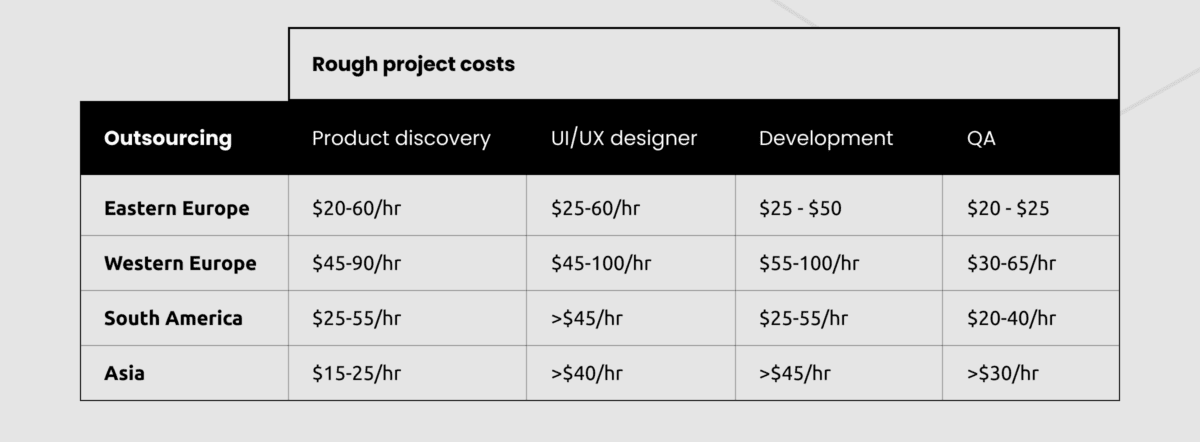

For more information on project timelines, below you can also see RewiSoft’s timeline calculations based on project size and stage.
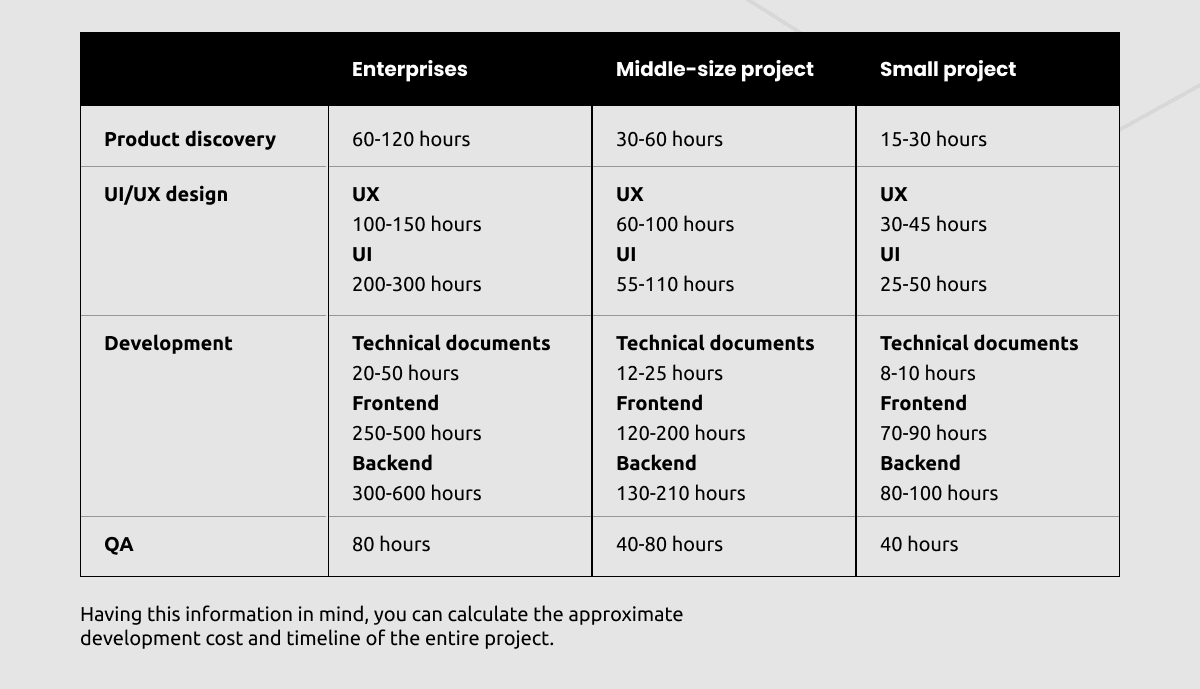

time
EdTech application development: Conclusion
To successfully enter into the community of the most reputable EdTech businesses, having only an idea is not enough. You will need a professional team to conduct an in-depth idea analysis and determine its place in the market.
RewiSoft’s expertise allows our specialists to be ready to jump into EdTech software development after reviewing a customer’s request. We use cutting-edge technology and efficient product development practices to develop industry-compliant and scalable EdTech solutions. We can assist you at any project stage and build intuitive and feature-rich educational mobile and web solutions.
To reach us now, tap the link.










